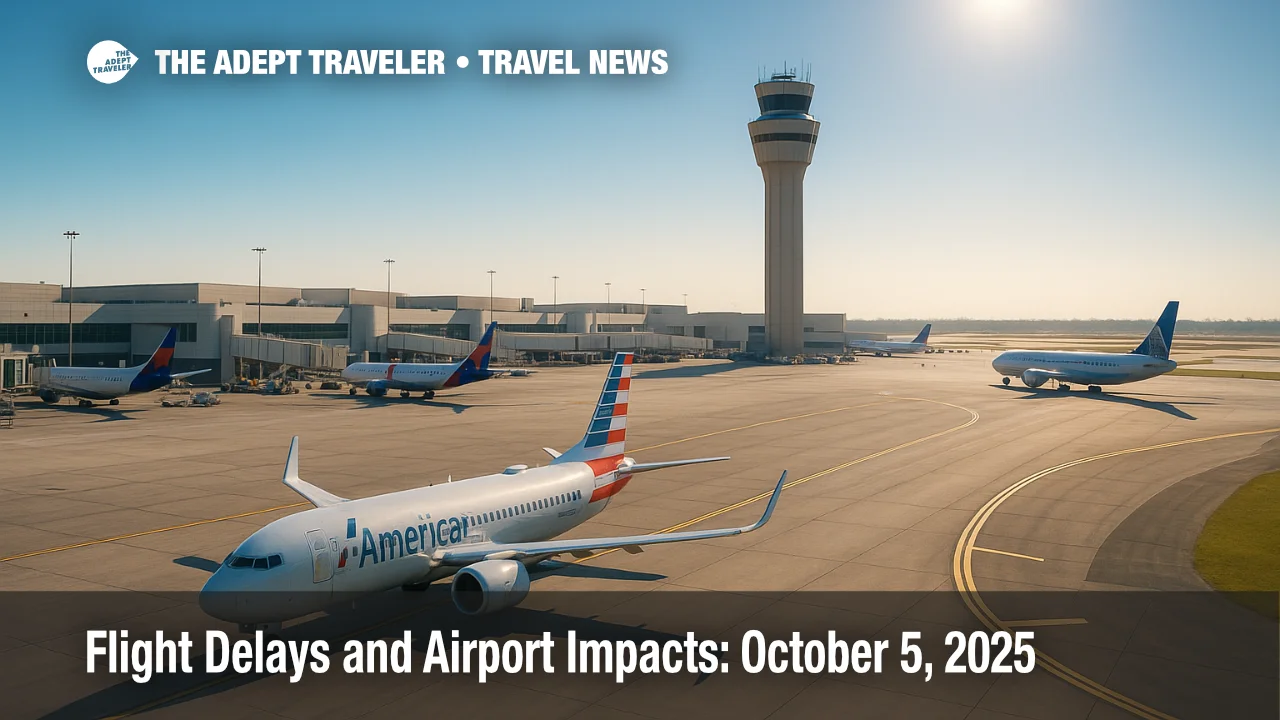Flight delays and airport impacts: October 5, 2025

Storm clusters building over Florida and the Gulf, plus spotty low ceilings in the Pacific Northwest, set up a choppy but manageable Sunday. The FAA's game plan flags potential ground stops or delay programs this afternoon for South Florida, Central Florida, Boston, and Minneapolis, while routine construction and special-use airspace create local pinch points at several hubs. Travelers should pad connections and watch for rolling traffic management initiatives as storms pulse through peak banks.
Key points
- Why it matters: Storm-driven constraints could cascade into missed connections and evening arrivals.
- Travel impact: MIA, FLL, MCO, TPA, BOS, and MSP face the greatest delay risk after 2:00 p.m. ET.
- What's next: Florida convective patterns typically peak late day; expect holds and reroutes into the evening.
- Low ceilings at SEA may require spacing; winds could slow LAS and MSP departures.
- SNA Pacific Airshow TFR and runway projects at major hubs add friction.
Snapshot
The FAA's Operations Plan highlights scattered thunderstorms across Florida and the Gulf routes, with staffing triggers posted for Denver tower operations and Washington Center sectors. South Florida, Central Florida, Boston Logan International Airport (BOS), and Minneapolis-Saint Paul International Airport (MSP) are on the watch list for possible ground stops or ground delay programs after 2:00 p.m. ET. Low clouds linger around Seattle-Tacoma International Airport (SEA), and winds could affect Las Vegas and Minneapolis rates. A temporary flight restriction for the Pacific Airshow overlays John Wayne Airport (SNA), and ongoing runway or taxiway work persists at Tampa International Airport (TPA), Orlando International Airport (MCO), George Bush Intercontinental Airport (IAH), San Francisco International Airport (SFO), Boston, and others. Expect dynamic routing on Gulf and Atlantic tracks as storms flare.
Flight Delays and Airport Impacts: October 4, 2025
Background
Sunday traffic typically features heavy leisure flows into Florida and the Northeast, amplifying the effect of even modest convective cells. Airspace programs like Structured Routing or SWAP can keep traffic moving, but late-day storm growth often forces ground stops or ground delay programs to meter arrivals safely. Construction closures further constrain runway configurations, cutting airport acceptance rates during peak pushes. Today, Boston Logan International Airport (BOS) continues a runway closure, Tampa International Airport (TPA) has a runway closed through late October, and Orlando International Airport (MCO) remains down one long runway, tightening margins if storms pulse at the wrong time. Add a show-day TFR over John Wayne Airport (SNA) for the Pacific Airshow, and tactical options can narrow quickly.
France ATC strike suspended for October 7-9
Latest developments
Florida thunderstorms may prompt ground stops and delay programs
The FAA plan calls out thunderstorms over Fort Lauderdale-Hollywood International Airport (FLL), Miami International Airport (MIA), Orlando International Airport (MCO), and Tampa International Airport (TPA). From midafternoon, traffic management initiatives are possible, including ground stops or ground delay programs to manage arrival rates. En route, Jacksonville Center and Miami Center list storm-related constraints, with potential escape or regional routes and SWAP activity into the evening. Gulf route closures remain probable as convection pops offshore, and portions of Atlantic oceanic routes may close intermittently.
Northeast and Upper Midwest: BOS and MSP on the watch list
Boston is listed for a potential ground stop or delay program after 2:00 p.m. ET, reflecting both runway work and convective risk along arrival gates. Minneapolis-Saint Paul International Airport (MSP) is flagged for winds and possible initiatives later today. Washington Center maintains an NRP suspension through October, which can channel traffic and limit flexibility when weather encroaches. Expect spacing and occasional miles-in-trail on busy flows from the Midwest into the Northeast this afternoon.
West: Low ceilings at SEA; airshow TFR at SNA
Seattle-Tacoma International Airport (SEA) starts the day with low ceilings manageable by instrument procedures, but brief arrival metering is possible. John Wayne Airport (SNA) sits under an airshow TFR until 4:59 p.m. PT, which can alter VFR corridors and pattern work. Construction advisories continue at San Francisco International Airport (SFO) and San Diego International Airport (SAN), with taxiway rehabilitation and phased airfield work noted in the plan.
Analysis
Operationally, today is classic shoulder-season convective management. Florida storms often pulse strongest between 200 p.m. and 700 p.m. local, overlapping with leisure-heavy arrival banks at Miami International Airport (MIA), Fort Lauderdale-Hollywood International Airport (FLL), and Orlando International Airport (MCO). When cells sit over final approach fixes, the Command Center may pivot from miles-in-trail to a ground stop, then relax to a ground delay program as cells drift. Boston Logan International Airport (BOS), with Runway 09/27 closed, has fewer configuration options; any showers or ceiling drops can hit acceptance rates harder than usual. Meanwhile, the SNA Pacific Airshow and multiple runway projects at Tampa International Airport (TPA), George Bush Intercontinental Airport (IAH), and San Francisco International Airport (SFO) reduce slack in the system. The en route picture shows likely Gulf and Atlantic route closures, so longer routings and airborne holds can stack up quickly. Bottom line, schedule buffers matter today, especially for Florida connections and BOS evening arrivals.
Final thoughts
Build an extra hour into Florida itineraries and watch airline apps for EDCT assignments if a ground delay program spins up at Miami International Airport (MIA), Fort Lauderdale-Hollywood International Airport (FLL), Orlando International Airport (MCO), or Tampa International Airport (TPA). If your journey touches Boston Logan International Airport (BOS) or Minneapolis-Saint Paul International Airport (MSP), expect periodic spacing and possible holds around the evening push. Keep notifications on, hydrate, and plan alternative connections where you can. Smooth skies come and go, but smart planning beats surprises on a day like this for flight delays and airport impacts.
